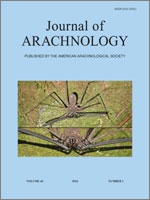Homalonychus selenopoides Marx, 1891 is endemic to the Sonoran Desert in Mexico and the southwestern United States. Despite its wide distribution in the desert, nothing is known about its phenology. For this study, we collected 464 immature and adult spiders and 67 egg sacs during late 2007 and throughout 2008. In the field, the life cycle is annual and phenology is markedly seasonal. Egg sacs and 2nd instar spiderlings occur in the field only from April–July, juveniles throughout the year, penultimate spiders from September–April, and adults of both sexes from November–April. Temperature and juvenile frequency were positively correlated (r2 = 0.9374; P < 0.0001), but temperature and adult frequency were negatively correlated (r2 = −0.8904; P < 0.0001). These spiders are active in winter and this is when the adults mature and mate. The phenology model proposed fits the winter-mature pattern of Aitchison (1984). Reproductive diapause governs the seasonal development of this species, which is possibly semelparous and univoltine.
How to translate text using browser tools
1 April 2016
Phenology of the Sonoran desert-endemic populations of Homalonychus selenopoides (Araneae: Homalonychidae)
José Andrés Alvarado-Castro,
María Luisa Jiménez
ACCESS THE FULL ARTICLE

The Journal of Arachnology
Vol. 44 • No. 1
April 2016
Vol. 44 • No. 1
April 2016
Homalonychids
reproductive diapause
Seasonality
winter-active
winter-mature




